|


|

|

Home Front
Some 12,000 Newfoundlanders, of an estimated population of 242,000, enlisted
during the war. Nearly as many again volunteered but were rejected. Thousands more were
involved behind the scenes, raising the fighting forces, outfitting them, training them, providing
comforts, looking out for their families, caring for returned soldiers and sailors, commemorating
them, and raising funds. Newfoundlanders were involved in virtually every aspect of the war
effort, for the war was fought on many fronts.
The war effort was concentrated in St. John’s (population 32,000). It was the social,
commercial and political centre of Newfoundland, and dominated 1,300 mostly small fishing
settlements. The pulp and paper town of Grand Falls, controlled by British newspaper interests,
was the only major inland centre. The Newfoundland Patriotic Association (NPA), the Women’s
Patriotic Association (WPA), the Newfoundland Regiment and the Royal Naval Reserve were
headquartered in St. John’s.
Women’s Patriotic Association workers at Government House, ca. 1914.
Courtesy of the Provincial Archives of Newfoundland and Labrador (PANL B-5-173), St. John’s,
Newfoundland.
 (52 Kb)
(52 Kb)
|
 |
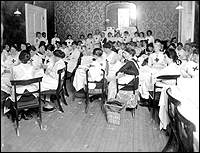
|
The NPA was intended to be broadly representative. It included the leading citizens of St.
John’s—merchants, lawyers, educators, journalists, city councillors, city clergymen, officers of all
city societies and unions, representatives of the cadet corps, Frontiersmen and rifle club, members
of the Legislature, and medical doctors, newspaper editors and magistrates throughout
Newfoundland. The make-up of its various committees and sub-committees was carefully
weighed and balanced along political and religious lines. Outport magistrates established outport
branches. Most soon lapsed, however, and the NPA remained overwhelmingly St. John’s based.
From the time it was announced in August 1914 that Newfoundland would raise a military force,
until the first 537 recruits headed overseas in October, war fever gripped St. John’s. Men
had to be selected, drilled and equipped, officers chosen, and transport arranged. There were banquets,
socials and farewell parties. Patriotic poetry, prose and song filled the press. It seemed the
whole town was involved. Not surprisingly, St. John’s provided the majority of the men, mostly from the
ranks of the cadet corps.
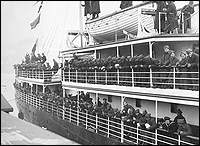
|
 |
D Company, First Newfoundland Regiment, lining rails of S.S. Stephano, ready to leave for
overseas, March 20, 1915.
Courtesy of the Provincial Archives of Newfoundland and Labrador (PANL VA-37-23), St. John’s,
Newfoundland.
 (49 Kb)
(49 Kb)
|
The first contingent had hardly sailed through the Narrows when enlistment was renewed
for a reserve force and the whole process began again. Before the war ended thousands of
soldiers, sailors and foresters would be assembled in St. John’s and dispatched overseas.
Throughout the war the city was on a virtual war footing, at times resembling an armed camp.
Patriotic fervour never abated. Not even the disastrous Somme offensive with its terrible toll of
young Newfoundlanders caused its citizens to falter, or Newfoundland’s continued participation to
be questioned.
Only in the company town of Grand Falls did support for the war effort rival that of St.
John’s. Large fishing towns, such as Carbonear and Harbour Grace, lagged far behind in terms of
enlistment. In St. John’s and Grand Falls a large number of men were engaged in trade and
manufacturing and could thus be spared without disastrous results for the city’s economy. In the
outports, however, where the health of the staple industry depended on an adequate supply of
young men, their absence could spell ruin.
Grand Falls downtown area, ca. 1909.
This early picture features three hotels, the Town
Hall, the Anglo Newfoundland Development (AND) Co. Store and the Company Barn.
Courtesy of the Heritage Society of Grand Falls-Windsor, Grand Falls-Windsor, Newfoundland.
 (68 Kb)
(68 Kb)
|
 |
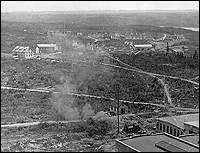
|
In smaller, more remote outports the war seemed distant. Some war news filtered through
and the occasional recruiting party called by. But for the most part it was the steadily
rising price of fish that concerned people most.
For three years the NPA directed recruitment. Small groups of returned men toured the
island, their efforts supplemented by fraternal organizations and local officials and dignitaries.
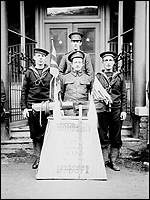
|
 |
Newfoundland military personal recruiting at Harbour Grace, ca. 1917.
The inscription on
the monument reads: "WHICH! Have you a reason or only an excuse for not enlisting NOW!"
Courtesy of the Provincial Archives of Newfoundland and Labrador (PANL NA-11028), St. John’s,
Newfoundland.
 (49 Kb)
(49 Kb)
|
Enlistments aside, Newfoundlanders as a whole were caught up in a whirl of patriotic
fund-raising and other charitable activity on behalf of the troops. Whether urban or rural, Catholic
or Protestant, rich or poor, young or old, they did not stint in their efforts. There was the Patriotic
Fund (designed to assist the dependents of combatants), the Belgian Relief Fund, the Khaki
Prisoners Fund, St. Dunstan’s Fund for Blind Soldiers and Sailors, the Mayo Lind Tobacco Fund,
the Fish and Brewis fund, the Aeroplane Fund, the Cot Fund, the Jensen Red Cross Fund, and a
host of others. An estimated $1,000,000 was raised, a truly magnificent effort.
There was much other work to be done. The women of Newfoundland busied themselves
with everything from the production of “comforts” to visiting the bereaved and entertaining the
troops. The needs of the wounded and disabled—pensions, medical care and civil re-establishment
programmes—occupied many. Women were also responsible for bringing in supplies, and ensuring that
the fish made it to market.
Pairs of knitted socks, ca. 1915.
5,276 pairs of socks knitted by the women of Newfoundland
- 2nd Contingent. One pair reached a knitter’s son.
Courtesy of the Centre for Newfoundland Studies Archives (Mary Southcott Collection 190),
Queen Elizabeth II Library, Memorial University of Newfoundland, St. John’s, Newfoundland.
 (39 Kb)
(39 Kb)
|
 |
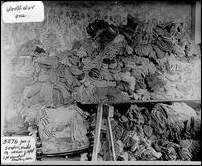
|
On the whole, Newfoundlanders did not suffer greatly from shortages of food and other
consumer products. But shortages threatened and prices leaped upwards, sometimes to more than
double their pre-war levels. Fortunately, the worldwide demand for food and other raw materials
meant higher fish prices, full employment and better wages. Conspicuous consumption and luxury
spending, it was said, were on the increase.
The most welcome effect of the war was increased trade and prosperity. Imports doubled
in value and exports soared. The government recorded a surplus of revenue over expenditure four
years in a row.
Newfoundland’s experience with the Great War on the Home Front was not so different
from Britain’s or Canada’s. The war engaged more than just a nation’s soldiers and seamen: it
required the mobilization of population and resources on an unprecedented scale in support of the
war effort. Newfoundland proved to be remarkably imaginative in organizing its war effort in
spite of a small population and limited resources. But the war also siphoned off a good part of the
country’s productive manpower and a significant portion of its wealth. The long-term costs of the
country’s involvement in the war were to be considerable.

|

|
 |